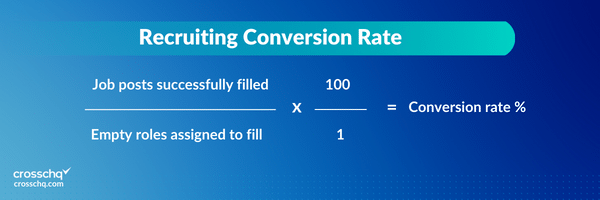

Crosschq Blog
What is Your Recruiting Conversion Rate Story Telling You?

An organization's recruiting conversion rate tells a story about how recruiting is going. However, this metric alone doesn’t provide the whole picture; for that, a few sequels are required.
When it comes to job conversion, the equation may seem simple: X number of candidates enter the pipeline, Y number end up getting hired. Express as a percentage, and that’s the recruiting conversion rate. But are all of those new hires what they seem?
Calculating the Recruiting Conversion Rate
Knowing how to calculate a recruiting conversion rate is the first step toward improving it. However, while the simplest calculation is the best place to start, it’s by no means the end of the story.
The basic recruiting conversion rate (or job conversion rate, as it is also often called) can be calculated like this:

Obviously, this percentage will shift over time, as more people are brought into the recruitment pipeline and varying numbers end up accepting an offer. At any rate, this conversion rate, while it tells how well a recruitment campaign is doing from the standpoint of effort put into attracting talent vs. seats filled, it doesn’t tell the entire story.
The Importance of More Recruitment Conversion Rate Analysis
To get the entire picture of recruitment conversion rates, it’s necessary to “read the whole book”. Start at the beginning, with the simple job conversion rate, then flesh out the story.
Chapter 1: Recruiter conversion rate
The recruitment conversion rate by recruiter metric separates the hiring funnel by recruiter and slots all candidates brought by them into the funnel into a single bucket. The percentage of actual hires made from that recruiter’s candidates can be compared against the percentage reached by other recruiters.
This can give hiring managers an idea of which recruiters are ultimately filling more seats, but this figure still lacks deeper insights into whether or not the seats are being filled with the right candidates or if they will stay filled. The recruiter-hiring manager relationship is key.
Chapter 2: Department conversion rate
It’s worth taking a closer look at the recruitment conversion rate by department as well. This bumps up the ultimate responsibility for hiring choices to the hiring managers for each department and can reveal if some hiring managers seem to have empty seats longer than others.
However, this can also ignore additional factors, like the difficulty of finding candidates with specific skill sets. Customer service roles are typically easier to fill than engineering roles. Additionally, entry-level employees are easier to hire than upper-level management positions.
Chapter 3: Source of hire conversion rates
A recruitment conversion rate broken down for each source of hire can reveal which are delivering the highest percentage of candidates hired and which are failing to generate applicants who turn into new hires.
Once again, this can only be viewed as a single factor out of many, as the quality of candidates acquired from each source must also be taken into account to prove its true value as a recruiting channel.
Chapter 4: New hire retention
Looking at retention as a facet of the recruitment conversion rate can tell hiring managers if the current hires being made are simply stopgaps to fill seats, or have longer-term value to the organization.
If any recruitment conversion rate seems good on the surface, but on closer inspection turns out to be just a revolving door, its true value as a metric must be questioned, and changes should be made to recruiting strategy.
Chapter 5: Quality of Hire
New hire retention can be viewed as a subset of the Quality of Hire metric, which also includes factors like hiring manager satisfaction, post-hire performance, and other candidate attributes that denote a high-quality employee.
If a recruitment conversion rate is high but Quality of Hire is dropping across the organization, current recruitment tactics are doing net harm rather than good, and could be costing the organization hundreds of thousands of dollars annually in lost productivity.
Strategies for Improving Recruiting Conversion Rates
To get to the happily ever after part of the story, you need to have positive matches between candidates and jobs or at least be data-driven. Understanding how to track recruited cohorts through the hiring pipeline and identify where top talent may be self-selecting out is a good place to start.
Segment conversion rates by funnel stage
Start by segmenting your conversion rate by each major stage in the hiring funnel. Look at individual conversions, including:
- % of offers made to candidates from various sources
- % of interviews with candidates brought in by different recruiters
- % of interviews that result in an offer
- % of offers accepted
Being able to surface where the main conversion rate breaks down into different parts of the candidate journey can help you see where top talent may be leaving the process before they reach the offer stage.
This is also an area where you can look closely at DEIB metrics across the candidate journey. If diverse candidates aren’t converting, there needs to be more scrutiny in the hiring process.
Review recruiter performance
Look closely at individual recruiter performance. Recruiters who have a high conversion rate from the screening stage to interview, but who don’t ultimately land candidates with a successful offer, may need to work on their interview technique.
Recruiters with a low client interview-to-offer rate and low overall job-to-placement rate may be experiencing a disconnect between what they think the employer needs and what is really required in a desirable candidate.
Recruiters whose conversion rates are low across the board compared to other recruiters working in the same departments may not be a good fit for the job. Those who have high conversion rates but low volume could simply need to be shifted to a new market, or used as closers.
Improve the candidate experience
The application and hiring process can easily be burdensome and discouraging to in-demand talent. As many as 50% of workers say they have rejected an offer because of a bad recruiting experience. Review the following parts of your hiring funnel to see if any of them are causing friction:
-
Mandated candidate account creation processes
-
Demands for personal information instead of questions about attributes/experience
-
Online applications that are not optimized for mobile
-
Applications and assessments that take hours instead of minutes
-
Lack of timely communication and/or feedback

Using the following platforms, tools, and processes can help you give candidates the experience they demand (and deserve):
-
App-driven applications that allow completion via mobile devices
-
AI (such as chatbots) to answer candidate questions
-
Automation (like digital reference checking) to keep candidates from getting stalled
-
Interview scheduling tools to ensure interviews are set up swiftly
-
Communication triggers to ensure candidates aren’t left hanging at critical intervals
A bad candidate experience can cause an organization to lose both top-talent prospects and customers. A great experience can help build a pool of passive talent that can be tapped back into later for future job postings.
Ready to get a happy-ever-after from your recruiting conversion rate? Contact us for a free demo today.
Take the Guesswork
Out of Hiring
Schedule a demo now



%20-200x43.png)






